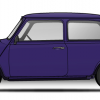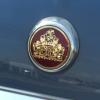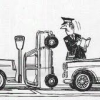
Caliper Cross-Threaded
#1

Posted 28 September 2011 - 06:39 PM
I brought a 7.5" Cooper S set up a while ago and I'm at the stage of bleeding the system. On one of the caliper bleed nipple threads it appears that two threads have been cross threaded but the rest are perfect (not quite sure how this was done! :S).
But would it be possible to just clean out the thread by using a tap? If so, does anybody no what thread size tap I would need?
If there is any better way to sort this without drilling or using helicoils.
Thanks
#2

Posted 28 September 2011 - 07:00 PM
#3

Posted 28 September 2011 - 07:10 PM
#4

Posted 28 September 2011 - 08:04 PM
The correct tapping drill for the 3/8" UNF will remove the damaged threads completely.
#5

Posted 28 September 2011 - 08:33 PM
#6

Posted 28 September 2011 - 08:47 PM
Then you drill with the tapping size drill in the kit, and using a tap wrench you tap that hole to thread it with the tap provided. You then wind in the Heli-Coil with the insertion tool and snap off the tang on the inner end of the Heli-Coil. Then you fit the bleed screw and 'jobsagoodun'.
Actually I think the thread inserts sold by Namrick are called 'Re-Coil' kits, but it's the same thing.
#7

Posted 29 September 2011 - 12:07 AM
Yes brakes are a safety related area. However, you are MUCH less likely to have a good outcome by trying to drill and tap for a Helicoil than by chasing the threads that are already there on the caliper. The existing tapped hole is already concentric with the seat. To fit the Helicoil properly you will need to fixture the caliper accurately so everything remains "on center".
Measure the brake bleed nipple for the thread size. From memory I believe it is 3/8 UNF. There are three styles of taps, taper, plug, and bottoming. Get a new, sharp plug tap and chase the threads in your caliper. Once the damaged threads are re-cut, you are done. Do not go deeper than you have to. Make sure you flush out all the swarf.
As footnote #1 my advice is to put a little anti-seize compound on the threads of the nipple prior to installation.
Footnote #2 is to suggest thoroughly degreasing the area around the nipple once the brakes are bled so you can monitor for any leaks around the nipple.
And footnote #3, when you fit these calipers, remember that the bleed nipples go to "UP" at the top of the caliper, not at the bottom. You won't be able to bleed the calipers with the nipples pointed down.
#8

Posted 29 September 2011 - 09:51 AM
Thanks for all the advice.
#9

Posted 29 September 2011 - 10:54 AM
A new caliper from mini spares is only £84, is it really worth risking your life and mini?
Just try to stop at 30mph using only the hand brake, knowing the foot brake works.
John
#10

Posted 29 September 2011 - 11:46 AM
is it really worth risking your life and mini?
Bleed nipple problems are not really quite as dangerous as say... re-using old seals or friction materials. The issue, the failure mode, is leakage. The nipple isn't going to "shoot out" under braking and leave you with a sudden loss of stopping power.
Let's take one quick paragraph to do some math. The nipple is 3/8 UNF. Let's say that the nipple does not seat so ALL the brake fluid pressure is felt by the major diameter of the thread (very unlikely). Further, let's say that your pedal effort creates 1000 PSI in the system. 1000 PSI x (3/8 squared x Pi ) / 4 = 110 pounds. That is almost nothing when there are three or four threads in engagement. So.. this is NOT going to be a catastrophic failure. Again, the failure mode is leakage and you will know within moments following a static test if you have a problem. The nipple is either going to seat or it is not.
Still don't like the idea of chasing the threads? There are alternatives you can pursue at home. See the product in the link below. I have used similar on VW calipers rather than replace them. The product does work and is a better solution than a Helicoil because the whole nipple/seat assembly is inserted as one. This eliminates the possibility of concentricity errors.
Nipple repair kit: http://www.levineaut...ederrepair.html
Someone in the U.K. is bound to carry a similar product.
#11

Posted 29 September 2011 - 11:06 PM
Ok that’s your take on the problem,
But in the UK if you are involved in fatal/ or near fatal traffic accident, the police take the car for inspection,
oh look brake fluid loss or no bleed nipple = brake failure, who’s to blame, the police always look for blame.
John
Foot note
thanks for the bodge link
#12

Posted 30 September 2011 - 01:10 AM
That link is not to a "bodge" product. It is a much more practical DIY repair than trying to Helicoil a bleed nipple hole. If it were considered a bodge by your MOT boards or motor vehicle regulatory agencies I am sure the kits would not be legal for sale in the U.K. The following links are for two such items that are for sale in the U.K.
http://www.ebay.co.u...c-/170683443953
http://www.hellopro....fr-societe.html
From the OP's opening post: " it appears that two threads have been cross threaded but the rest are perfect"
I cannot stress enough that the failure mode is leakage, not shooting the nipple out. If you Helicoil the caliper the nipple is not going to be concentric with the seat and it will leak. I can all but guarantee you that if you took a caliper meeting the OP's description to a machine shop, they would chase the threads just enough to restore the fit of the bleed nipple.
#13

Posted 30 September 2011 - 07:03 AM
Attached Files
#14

Posted 30 September 2011 - 10:14 AM
Whichever way you do it, so long as it doesn't leak when the pedal is pushed down as hard as you can then it's fine.
Edited by Cooperman, 30 September 2011 - 10:15 AM.
#15

Posted 30 September 2011 - 12:45 PM
Thanks for all you help. I will post the outcome of cleaning the thread out!
1 user(s) are reading this topic
0 members, 1 guests, 0 anonymous users


















